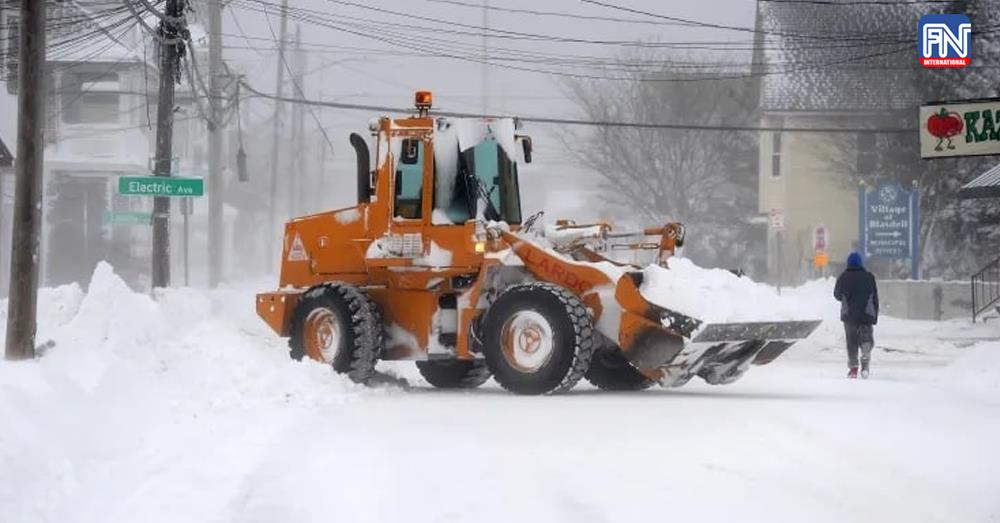WASHINGTON, Dec 26 (AFP) - A “once-in-a-lifetime” blizzard has killed at least 57 people in the U.S., including 27 in western New York’s Erie County, officials said Monday.
The number of deaths from the monstrous storm was expected to grow as snow continued to blanket Erie County, leaving roads in many areas impassable, including the majority of Buffalo, County Executive Mark Poloncarz said at a news conference.
“We can see sort of the light at the end of the tunnel, but this is not the end yet,” Poloncarz said. “We are not there.”
Snow was expected to fall in Erie County into Tuesday afternoon. Nationwide, temperatures plummeted, and huge snow drifts have snarled travel and trapped people inside their homes.
Stretching from the Great Lakes near Canada to the Rio Grande along the Mexican border, the storm had killed at least 57 people as of Monday morning, according to an NBC News tally. The deaths were recorded in 12 states: Colorado, Illinois, Kansas, Kentucky, Michigan, Missouri, Nebraska, New York, Ohio, Oklahoma, Tennessee and Wisconsin.
The medical examiner’s office in Erie County determined the 27 deaths there to be directly related to the blizzard, Poloncarz said.
He said many died from heart problems while shoveling or blowing snow. Others were found dead in their cars. At least one person in Niagara County died from carbon monoxide poisoning, he said.
At least 18 people died in Buffalo, Mayor Byron Brown said Monday afternoon.
Some of those deaths are not included in Erie County’s official tally, Poloncarz said, adding that the county was working to confirm them.
The ferocity of the storm was unlike that of any the region has seen, Poloncarz said. The snow fell “with a vengeance,” he said.
“It’s a generational storm,” he said, and the county has yet to begin assessing the “full toll.”
On Monday morning, a “band of heavy lake effect snow” in the Buffalo area was producing 2 to 3 inches of hourly snowfall, with accumulations reaching 6 to 12 inches and as much as 1 to 2 feet in Jefferson and northern Lewis counties, the National Weather Service said in its 6:43 a.m. bulletin.
The “lake effect” occurs when cold air passes over the unfrozen and warmer lake water, transferring moisture and warmth to the lower parts of the atmosphere. The air then rises to form clouds, resulting in intense snow.
“We know that the storm is coming back,” New York Gov. Kathy Hochul said Monday afternoon, calling the blizzard “one for the ages.”
Hochul tweeted that she had spoken to President Joe Biden and that he had “promised to swiftly approve” a request for a federal emergency disaster declaration. The White House echoed that, saying Biden offered “the full force of the federal government in support of the people of New York as the state grapples with the impacts of a historic winter storm.”
In Buffalo, blinding blizzards and freezing rain had at one point left more than 20,000 customers without power, Brown said. By Monday afternoon, the figure had dropped to less than 10,000.
Thousands of service crew members were deployed to deal with the emergency, which was probably “the largest mobilization of utility crews in the history of the state,” Hochul said.
The storm that battered Buffalo, with high winds and whiteout conditions, was compared to the famous Blizzard of 1977, which lasted three days.
“This was two days of terrible conditions, but the ferocity of the storm was worse than the blizzard of ’77,” Poloncarz said Monday.
The 1977 storm was called the “Blizzard That Buried Buffalo.” Twenty-nine people died, most of them trapped in their vehicles, according to the Northeast Regional Climate Center.
Over 49 inches of snow, or more than 4 feet, had fallen at Buffalo’s airport, the National Weather Service said Monday. Power substations were frozen over and in some places were covered by snowdrifts, Poloncarz said.
